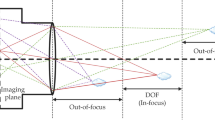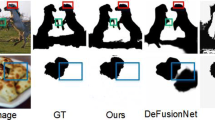Abstract
Defocus blur detection (DBD) is a classical low level vision task. It has recently attracted attention focusing on designing complex convolutional neural networks (CNN) which make full use of both low level features and high level semantic information. The heavy networks used in these methods lead to low processing speed, resulting difficulty in applying to real-time applications. In this work, we propose novel perspectives on the DBD problem and design convenient approach to build a real-time cost-effective DBD model. First, we observe that the semantic information does not always relate to and sometimes mislead the blur detection. We start from the essential characteristics of the DBD problem and propose a data augmentation method accordingly to inhibit the semantic information and enforce the model to learn image blur related features rather than the semantic features. A novel self-supervision training objective is proposed to enhance the model training consistency and stability. Second, by rethinking the relationship between defocus blur detection and salience detection, we identify two previously ignored but common scenarios, based on which we design a hard mining strategy to enhance the DBD model. By using the proposed techniques, our model that uses a slightly modified U-Net as backbone, improves the processing speed by more than 3 times and performs competitively against state of the art methods. Ablation study is also conducted to verify the effectiveness of each part of our proposed methods.
Work was partly supported by National Key Research and Development Program of China 2018AAA0100704, NSFC (61972250, U19B2035), and SJTU Global Strategic Partnership Fund (2020 SJTU-CORNELL).
Access this chapter
Tax calculation will be finalised at checkout
Purchases are for personal use only
Similar content being viewed by others
References
Chen, L., Zhu, Y., Papandreou, G., Schroff, F., Adam, H.: Encoder-decoder with atrous separable convolution for semantic image segmentation. ar**v\({:}\) Computer Vision and Pattern Recognition (2018)
Elder, J.H., Zucker, S.W.: Local scale control for edge detection and blur estimation. IEEE Trans. Pattern Anal. Mach. Intell. 20(7), 699–716 (1998)
Golestaneh, S.A., Karam, L.J.: Spatially-varying blur detection based on multiscale fused and sorted transform coefficients of gradient magnitudes. In: Computer Vision and Pattern Recognition, pp. 596–605 (2017)
Hinton, G.E., Srivastava, N., Krizhevsky, A., Sutskever, I., Salakhutdinov, R.: Improving neural networks by preventing co-adaptation of feature detectors. ar**v\(:\) Neural and Evolutionary Computing (2012)
Hou, Q., Cheng, M., Hu, X., Borji, A., Tu, Z., Torr, P.H.S.: Deeply supervised salient object detection with short connections. IEEE Trans. Pattern Anal. Mach. Intell. 41(4), 815–828 (2019)
Huang, R., Feng, W., Fan, M., Wan, L., Sun, J.: Multiscale blur detection by learning discriminative deep features. Neurocomputing 285, 154–166 (2018)
Ioffe, S., Szegedy, C.: Batch normalization: accelerating deep network training by reducing internal covariate shift. ar**v\(:\) Learning (2015)
Kingma, D.P., Ba, J.: Adam: a method for stochastic optimization. ar**v\(:\) Learning (2014)
Krizhevsky, A., Sutskever, I., Hinton, G.E.: ImageNet classification with deep convolutional neural networks. Neural Inf. Process. Syst. 141(5), 1097–1105 (2012)
Liu, R., Li, Z., Jia, J.: Image partial blur detection and classification. Comput. Vis. Pattern Recognit., 1–8 (2008)
Pang, Y., Zhu, H., Li, X., Li, X.: Classifying discriminative features for blur detection. IEEE Trans. Syst. Man Cybern. 46(10), 2220–2227 (2016)
Park, J., Tai, Y.W., Cho, D., Kweon, I.S.: A unified approach of multi-scale deep and hand-crafted features for defocus estimation. In: Computer Vision and Pattern Recognition (2017)
Ronneberger, O., Fischer, P., Brox, T.: U-net: convolutional networks for biomedical image segmentation. In: Navab, N., Hornegger, J., Wells, W.M., Frangi, A.F. (eds.) MICCAI 2015. LNCS, vol. 9351, pp. 234–241. Springer, Cham (2015). https://doi.org/10.1007/978-3-319-24574-4_28
Rutishauser, U., Walther, D., Koch, C., Perona, P.: Is bottom-up attention useful for object recognition? In: Computer Vision and Pattern Recognition, vol. 2, pp. 37–44 (2004)
Saad, E., Hirakawa, K.: Defocus blur-invariant scale-space feature extractions. IEEE Trans. Image Process. 25(7), 3141–3156 (2016)
Shi, J., Li, X., Jia, J.: Discriminative blur detection features. In: Computer Vision and Pattern Recognition (2014)
Simonyan, K., Zisserman, A.: Very deep convolutional networks for large-scale image recognition. ar**v\(:\) Computer Vision and Pattern Recognition (2014)
Su, B., Lu, S., Tan, C.L.: Blurred image region detection and classification. In: ACM Multimedia, pp. 1397–1400 (2011)
Tai, Y., Brown, M.S.: Single image defocus map estimation using local contrast prior. In: International Conference on Image Processing, pp. 1777–1780 (2009)
Tang, C., Wu, J., Hou, Y., Wang, P., Li, W.: A spectral and spatial approach of coarse-to-fine blurred image region detection. IEEE Signal Process. Lett. 23(11), 1652–1656 (2016)
Tang, C., Zhu, X., Liu, X., Wang, L., Zomaya, A.: DeFusionNET: defocus blur detection via recurrently fusing and refining multi-scale deep features. In: Proceedings of the IEEE Conference on Computer Vision and Pattern Recognition, pp. 2700–2709 (2019)
Vu, C.T., Phan, T.D., Chandler, D.M.: S3: a spectral and spatial measure of local perceived sharpness in natural images. IEEE Trans. Image Process. 21(3), 934–945 (2012)
Xu, G., Quan, Y., Ji, H.: Estimating defocus blur via rank of local patches. In: Computer Vision and Pattern Recognition, pp. 5381–5389 (2017)
Zeiler, M.D., Krishnan, D., Taylor, G.W., Fergus, R.: Deconvolutional networks. In: Computer Vision and Pattern Recognition (2010)
Zhang, S., Shen, X., Lin, Z., Mech, R., Costeira, J.P., Moura, J.M.F.: Learning to understand image blur. In: Computer Vision and Pattern Recognition, pp. 6586–6595 (2018)
Zhang, Y., Hirakawa, K.: Blur processing using double discrete wavelet transform. In: Computer Vision and Pattern Recognition, pp. 1091–1098 (2013)
Zhao, J., Feng, H., Xu, Z., Li, Q., Tao, X.: Automatic blur region segmentation approach using image matting. Signal Image Video Process. 7(6), 1173–1181 (2012). https://doi.org/10.1007/s11760-012-0381-6
Zhao, W., Zhao, F., Wang, D., Lu, H.: Defocus blur detection via multi-stream bottom-top-bottom network. IEEE Trans. Pattern Anal. Mach. Intell. (2019)
Zhao, W., Zheng, B., Lin, Q., Lu, H.: Enhancing diversity of defocus blur detectors via cross-ensemble network. In: Computer Vision and Pattern Recognition, pp. 8905–8913 (2019)
Zhu, X., Cohen, S., Schiller, S.N., Milanfar, P.: Estimating spatially varying defocus blur from a single image. IEEE Trans. Image Process. 22(12), 4879–4891 (2013)
Zhuo, S., Sim, T.: Defocus map estimation from a single image. Pattern Recognit. 44(9), 1852–1858 (2011)
Author information
Authors and Affiliations
Corresponding author
Editor information
Editors and Affiliations
Rights and permissions
Copyright information
© 2020 Springer Nature Switzerland AG
About this paper
Cite this paper
Zhang, N., Yan, J. (2020). Rethinking the Defocus Blur Detection Problem and a Real-Time Deep DBD Model. In: Vedaldi, A., Bischof, H., Brox, T., Frahm, JM. (eds) Computer Vision – ECCV 2020. ECCV 2020. Lecture Notes in Computer Science(), vol 12355. Springer, Cham. https://doi.org/10.1007/978-3-030-58607-2_36
Download citation
DOI: https://doi.org/10.1007/978-3-030-58607-2_36
Published:
Publisher Name: Springer, Cham
Print ISBN: 978-3-030-58606-5
Online ISBN: 978-3-030-58607-2
eBook Packages: Computer ScienceComputer Science (R0)




